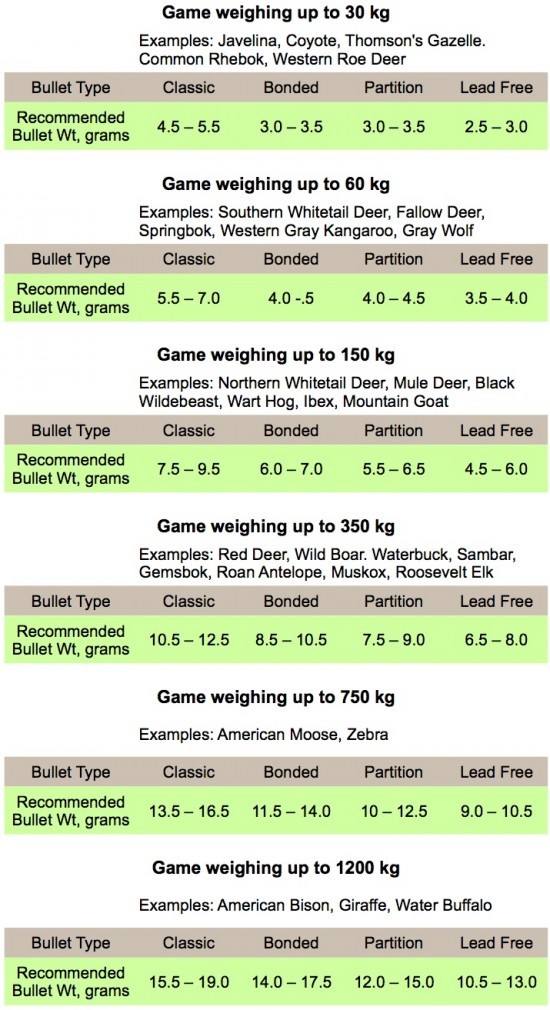Navigation Buttons —
| Ideal Weight | Ideal Weight | The Paper | Appendix A | Appendix B | Appendix C | Appendix D |
|---|---|---|---|---|---|---|
| Imperial Units | Metric Units | Defining Ideal Bullet Weight | Math Model | Min. Wound | Depth and Vel. | Depth and Dia. |
Update 4/25/14: This page has been updated to be a quick summary of the principles and conclusions of the Ideal Bullet Weight concept. The original page, which focuses on why and how the recommendations below were developed, now has the title Defining Bullet Weight and can be accessed by using this link.
* * * * * * *
A good way of thinking of what bullet weight is “ideal” is to consider the balance between one’s ability to hit the vital zone and the size of the bullet needed when it gets there. For the most part, this balance takes one to the lightest weight bullet for a caliber and that happens also to be heavy enough to routinely anchor reasonably well hit game.
The tables below present the lightest bullet of a design type suggested for each of six game weight classes. These bullet weights should create a wound channel big enough to cause the animal to faint within about ten seconds of being hit in the vital zone of the thorax. The odds of losing a wounded animal to a long and painful death increase dramatically as one drops below the recommended calibers and bullet weights for a given game species. Conversely, recoil from using significantly heavier than necessary bullets often results in poorly hit and lost animals. This is one of the problems that relatively inexperienced shooters unknowingly face when they go to a super-magnum caliber that is much more gun than is needed to reliably anchor their quarry.
Recommended Weights in the Metric System

Go here for details describing the methodology: Defining Ideal Bullet Weight
Descriptions of the bullet types, Classic, Bonded, Partition, and Lead-Free are at the bottom of this page.
Should you prefer seeing bullet weights in grains and animal weights in pounds, Go to this page for charts using the imperial system of measurements.
The interesting thing is that the suggestions are valid as long as the impact velocity is within the manufacturer’s recommended envelope. This is usually between 600 and 900 meters per second. Not all bullets perform within the bounds suggested by this 300 meter per second window. Check your bullet manufacturer’s literature to see if the velocity window is significantly different.
Further, test results suggest that the recommendations are effectively independent of caliber. A 6.5-gram 6-mm bullet behaves the same as 6.5-gram 6.5 mm bullet when both are of the same design. Similarly, a 10-gram 6.5-mm bullet behaves the same as a 10-gram 8-mm bullet.
A notable exception to going with the lightest bullet that will give good reliability in anchoring game happens when one determines the hunting load has light enough recoil that dozens of shots can be comfortably taken in a single session. For example, the .243 Winchester with 100 grain classic bullets weighing 100 grains and the .257 Roberts with 100 to 117 grain bullets are good for all but the heaviest North American deer. Recoil for both cartridges is about 10 ft-lb with an 8 lb rifle. This level of recoil means that a shooter can shoot many shots from different positions or from the bench in a single session without undue discomfort.
So, if your game rifle produces this level or recoil, why not do all shooting with your favorite game load? This would give plenty of practice and varmints or paper targets won’t know the difference!
Definitions of bullet types
Classic Bullets –
Classic bullets include soft point, hollowpoint, and unbonded plastic tipped bullets like Core-Loct®, Hunting VLD®, and Ballistic Tip®. Bullets of this type designed for medium game tend to show large expansion for velocity with sometimes spectacular disruption at higher velocities.
Bonded Bullets –
Bonded bullets are those where the lead core is bonded to the jacket. The copper supports the lead during expansion whch makes these bullets tend to hold together better than the unbonded classic bullet. Futher, these bullets are frequently designed for excellent exterior ballistics performance, including plastic tip. Hence drop and wind drift are somewhat more favorable to the hunter. Examples incude the Accubond®. InterBond®, and the Scirocco II®.
Partition Bullets –
Partition bullets represent the first of the premium bullets to be introduced in the USA, starting with the Nosler Partition in the late 1940s. The partition may have been inspired by the H-Mantel® first introduced by RWS in 1934. Partition bullets have developed a well-deserved reputation for anchoring game in difficult circumstances. Notice also that both these and bonded bullets can be somewhat lighter than those of classic design and still meet the performance criteria. Examples include Nosler Partition® and Swift A-Frame®.
Lead-Free Expanding Bullets –
In spite of the misfortune of being the centerpiece of arguably anti-gun legislation aimed at banning lead ammunition, the designs of lead-free hunting bullets give excellent performance on medium game. Indeed, one would need to add about 60% to the weight of the bullet to get similar terminal performance using classic bullets. This reduction in threshold bullet weight means that the hunter can choose a smaller caliber and lighter rifle resulting in less weight to carry in the field and a significant reduction in recoil. Both of those features give the hunter better chances of taking the correct shot when the time comes. Examples include the Barnes TSX®, TTSX®, Hornady GMX®, GS Custom HV®, etc.
Navigation Buttons —
| Ideal Weight | Ideal Weight | The Paper | Appendix A | Appendix B | Appendix C | Appendix D |
|---|---|---|---|---|---|---|
| Imperial Units | Metric Units | Defining Ideal Bullet Weight | Math Model | Min. Wound | Depth and Vel. | Depth and Dia. |

 sending...
sending...